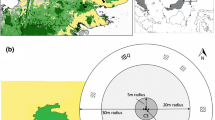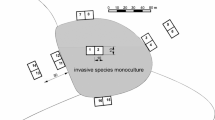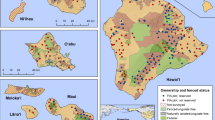Abstract
The spread of non-native species into natural communities is a noticeable phenomenon linked to global change. Drivers of such invasions, however, may differ according to specific regional environments. Here, we aim at disentangling the role of selected climate and non-climate drivers on the spread of native (Hedera helix and Ilex aquifolium) and non-native (Prunus laurocerasus and Trachycarpus fortunei) evergreen species in mature deciduous forests in southern Switzerland. Covers of target evergreens were determined using 200 quadratic plots of 100 m2, distributed on a regular grid of 100 × 100 m and spanning a steep climatic gradient ranging from −0.4 to 3.0 °C in the average temperature of the coldest month. Species covers were used as response variables to be related to climate, stand structure, disturbances, propagule pressure and geomorphology proxies by performing tobit regressions. Propagule pressure resulted to be the main driver of occurrence for three considered species, while meso-climate and stand structure played only a secondary role. In contrast, the presence of native I. aquifolium was mostly correlated with the temperature of the coldest month, though with an overall low impact on cover. Our study demonstrates different drivers of invasion for native and non-native species with similar life history traits. In particular, differences emerge from ecological requirements (niche) and propagule pressure. The ongoing spread of evergreen broadleaved species at the regional scale demonstrates how evergreens invade a largely empty ecological niche, mainly issued by land-use change rather than climate warming.



Similar content being viewed by others
References
Alpert P, Bone E, Holzapfel C (2000) Invasiveness, invasibility and the role of environmental stress in the spread of non-native plants. Perspect Plant Ecol Evol Syst 3:52–66. doi:10.1078/1433-8319-00004
Andergassen S, Bauer H (2002) Frost hardiness in the juvenile and adult life phase of ivy (Hedera helix L.) Plant Ecol 161:207–213. doi:10.1023/A:1020365422879
Anliker J (1950) Die im Freien aushaltenden Palmen der Südschweiz. Schweizerische Beiträge zur Dendrologie 2:33–51
Arnaud MT, Chassany JP, Dejean R, Ribart J, Queno L (1997) Economic and ecological consequences of the disappearance of traditional practices related to chestnut groves. J Environ Manag 49:373–391. doi:10.1006/jema.1995.0120
Banfi E, Galasso G (2008) Diffusione e invasività della palma Trachycarpus fortunei. In: Galasso G, Chiozzi G, Azuma M, Banfi E (eds) Le specie alloctone in Italia: censimenti, invasività e piani di azione. Memorie Società italiana di Sciente naturali / Museo civico di Storia naturale Milano, Milano, pp 21–22
Blackburn TM, Pysek P, Bacher S, Carlton JT, Duncan RP, Jarosik V, Wilson JRU, Richardson DM (2011) A proposed unified framework for biological invasions. Trends Ecol Evol 26:333–339. doi:10.1016/j.tree.2011.03.023
Blaser P (1973) Die Bodenbildung auf Silikatgestein im südlichen Tessin. Mitteilungen der Eidgenössen Forschungsanstalt für Wald, Schnee und Landschaft 49:253–340
Bodin J, Badeau V, Bruno E, Cluzeau C, Moisselin J-M, Walther G-R, Dupouey J-L (2013) Shifts of forest species along an elevational gradient in Southeast France: climate change or stand maturation? J Veg Sci 24:269–283. doi:10.1111/j.1654-1103.2012.01456.x
Callauch R (1983) Untersuchungen zur Biologie und Vergesellschaftung der Stechpalme (Ilex aquifolium). Gesamthochschule in Kassel, Kassel, p 186
Carloni T (1998) La grande trasformazione del territorio. In: Ceschi R (ed) Storia del cantone Ticino: il Novecento. Edizioni Casagrande, Bellinzona, pp 671–700
Carraro G, Gianoni P, Mossi R (1999) Climatic influence on vegetation changes: a verification on regional scale of the Laurophyllisation. In: Klotzli F, Walther GR (eds) Conference on recent shifts in vegetation boundaries of deciduous forests, especially due to general global warming. Birkhäuser Verlag, Basel, pp 31–51
Castagneri D, Garbarino M, Nola P (2013) Host preference and growth patterns of ivy (Hedera helix L.) in a temperate alluvial forest. Plant Ecol 214:1–9. doi:10.1007/s11258-012-0130-5
Chytry M, Pysek P, Wild J, Pino J, Maskell LC, Vila M (2009) European map of alien plant invasions based on the quantitative assessment across habitats. Divers Distrib 15:98–107. doi:10.1111/j.1472-4642.2008.00515.x
Conedera M, Hofmann C, Tinner W (1999) Vegetation shift and laurophyllisation: the possible role of forest fires. In: Klötzli F, Walther G-R (eds) Conference on recent shifts in vegetation boundaries of deciduous forests, especially due to general global warming. Birkhäuser Verlag, Basel, pp 69–84
Conedera M, Stanga P, Lischer C, Stöckli V (2000) Competition and dynamics in abandoned chestnut orchards in southern Switzerland. Ecol Mediterr 26:101–112
Conedera M, Stanga P, Oester B, Bachmann P (2001) Different post-culture dynamics in abandoned chestnut orchards. Forest Snow Landsc Res 76:487–492
Davis MA, Grime JP, Thompson K (2000) Fluctuating resources in plant communities: a general theory of invasibility. J Ecol 88:528–534. doi:10.1046/j.1365-2745.2000.00473.x
Delarze R, Caldelari D, Hainard P (1992) Effects of fire on forest dynamics in southern Switzerland. J Veg Sci 3:55–60. doi:10.2307/3235998
Dolezil J (2007) Die Bedeutung des Klimawandels und biotischer Interaktionen für die Ausbreitung der invasiven Palme Trachycarpus fortunei im Tessin. Master thesis, Georg-August-Universität zu Göttingen, Göttingen, pp. 120
Dullinger I, Wessely J, Bossdorf O, Dawson W, Essl F, Gattringer A, Klonner G, Kreft H, Kuttner M, Moser D, Pergl J, Pyšek P, Thuiller W, van Kleunen M, Weigelt P, Winter M, Dullinger S (2017) Climate change will increase the naturalization risk from garden plants in Europe. Glob Ecol Biogeogr 26:43–53. doi:10.1111/geb.12512
Ferrata C (2007) La Fabrication du paysage dans la région des lacs du Sud des Alpes. Le Globe 147:28–47
Fischer R (2004) Ilex aquifolium (Stechpalme). Verbreitung und Soziologie im Bezirk Kirchdorf/Krems in Oberösterreich. Beiträge zur Naturkunde Oberösterreichs 13:201–212
Freuler B (1906) Verbreitung der wichtigsten Kulturgewächse, sowie einiger ziemlich allgemein angebauter exotischer Zier- und Nutzhölzer im südl. Tessin Schweiz Gartenbau 19:108–109
Gianoni P, Carraro G, Klötzli F (1988) Thermophile, an laurophyllen Pflanzenarten reiche Waldgesellschaften im hyperinsubrischen Seenbereich des Tessins. Berichte des Geobotanischen Institutes, ETH, Stiftung Rübel, Zürich 54:164–180
Grund K, Conedera M, Schröder H, Walther GR (2005) The role of fire in the invasion process of evergreen broad-leaved species. Basic Appl Ecol 6:47–56. doi:10.1016/j.baae.2004.07.005
Gurvich DE, Tecco PA, Diaz S (2005) Plant invasions in undisturbed ecosystems: the triggering attribute approach. J Veg Sci 16:723–728. doi:10.1111/j.1654-1103.2005.tb02415.x
Heinrichs S, Schmidt W (2015) Dynamics of Hedera helix L. in central European beech forests on limestone: results from long-term monitoring and experimental studies. Plant Ecol 216:1–15. doi:10.1007/s11258-014-0412-1
Jantsch MC, Fischer A, Fischer HS, Winter S (2013) Shift in plant species composition reveals environmental changes during the last decades: a long-term study in beech (Fagus Sylvatica) forests in Bavaria, Germany. Folia Geobotanica 48:467–491. doi:10.1007/s12224-012-9148-7
Klötzli F, Walther GR (1999) Recent vegetation shifts in Switzerland. In: Klötzli F, Walther GR (eds) Conference on recent shifts in vegetation boundaries of deciduous forests, especially due to general global warming. Birkhäuser Verlag, Basel, pp 15–29
Krebs P, Stocker M, Pezzatti GB, Conedera M (2015) An alternative approach to transverse and profile terrain curvature. Int J Geogr Inf Sci 29(4):643–666. doi:10.1080/13658816.2014.995102
Küttel KY (2001) Vegetationskundliche Untersuchungen zur Ausbreitung immergrüner exotischer Gehölz eim Laganese. Master thesis. Zurich, University of Zurich, pp. 74
Labhart TP (2005) Geologie der Schweiz. Ott Verlag, Thun
Lockwood JL, Cassey P, Blackburn T (2005) The role of propagule pressure in explaining species invasions. Trends Ecol Evol 20:223–228. doi:10.1016/j.tree.2005.02.004
Lonsdale WM (1999) Global patterns of plant invasions and the concept of invasibility. Ecology 80:1522–1536. doi:10.1890/0012-9658(1999)080[1522:GPOPIA]2.0.CO;2
Marco A, Lavergne S, Dutoit T, Bertaudiere-Montes V (2010) From the backyard to the backcountry: how ecological and biological traits explain the escape of garden plants into Mediterranean old fields. Biol Invasions 12:761–779. doi:10.1007/s10530-009-9479-3
Metcalfe DJ (2005) Hedera helix L. J Ecol 93:632–648. doi:10.1111/j.1365-2745.2005.01021.x
MeteoSwiss (2017) Normal value charts. Total precipitation (30 years average 1981–2010. http://www.meteoswiss.admin.ch/home/climate/past/climate-normals/norm-value-charts.html?filters=precip_8110_yy. Accessed 3 March 2017
Møller LA, Skou A-MT, Kollmann J (2012) Dispersal limitation at the expanding range margin of an evergreen tree in urban habitats? Urban For Urban Green 11:59–64. doi:10.1016/j.ufug.2011.10.002
Moran EV, Alexander JM (2014) Evolutionary responses to global change: lessons from invasive species. Ecol Lett 17:637–649. doi:10.1111/ele.12262
Mosteller F, Tukey JW (1977) Data analysis and regression—a second course in statistics. Addison-Wesley, Reading
Müller A (2000) Zur Bedeutung der Vögel für die Ausbreitung von exotischen Pflanzen. Master thesis. ETH Zurich, Zurich, pp 81
Muster S, Elsenbeer H, Conedera M (2007) Small-scale effects of historical land use and topography on post-cultural tree species composition in an Alpine valley in southern Switzerland. Landsc Ecol 22:1187–1199. doi:10.1007/s10980-007-9099-1
Pezzatti GB, Reinhard M, Conedera M (2010) Swissfire: die neue schweizerische Waldbranddatenbank. Schweiz Z Forstwes 161:465–469
Pysek P, Richardson DM (2006) The biogeography of naturalization in alien plants. J Biogeogr 33:2040–2050. doi:10.1111/j.1365-2699.2006.01578.x
R Core Team (2016) A language and environment for statistical computing. R Foundation for Statistical Computing, https://www.r-project.org/. Accessed 29 December 2016
Rehm EM, Lenz A, Hoch G, Körner C (2014) Spring patterns of freezing resistance and photosynthesis of two leaf phenotypes of Hedera helix. Basic Appl Ecol 15:543–550. doi:10.1016/j.baae.2014.07.009
Richardson DM, Pysek P (2006) Plant invasions: merging the concepts of species invasiveness and community invasibility. Prog Phys Geogr 30:409–431. doi:10.1191/0309133306pp490pr
Schinz HR (1797) Descrizione della Svizzera italiana nel Settecento. Armando Dadò Editore, Locarno
Schnitzler A, Heuze P (2006) Ivy (Hedera helix L.) dynamics in riverine forests: effects of river regulation and forest disturbance. For Ecol Manag 236:12–17. doi:10.1016/j.foreco.2006.05.060
Schröter C, Schmid E (1956) Flora des Südens. Die Pflanzenwelt Insubriens (Täler zwischen Ortasee und Comersee). Rascher, Zürich
Simberloff D, Martin J-L, Genovesi P, Maris V, Wardle DA, Aronson J, Courchamp F, Galil B, Garcia-Berthou E, Pascal M, Pysek P, Sousa R, Tabacchi E, Vila M (2013) Impacts of biological invasions: what’s what and the way forward. Trends Ecol Evol 28:58–66. doi:10.1016/j.tree.2012.07.013
Sittig E (1998) Dendroökologische Rekonstruktion der Einwanderungsdynamik laurophyller Neophyten in Rebbrachen des südlichen Tessins. Master thesis, Philipps-Universität, Marburg/Lahn, pp. 138
Stahel WA (2013) The R-function regr and package regr0 for an augmented regression analysis. ETH Zürich. http://stat.ethz.ch/~stahel/regression/regr-description.pdf. Accessed 29 December 2016
Stokes DL, Church ED, Cronkright DM, Lopez S (2014) Pictures of an invasion: English Holly (Ilex aquifolium) in a semi-natural Pacific Northwest forest. Northwest Science 88:75–93. doi:10.3955/046.088.0204
Taylor KT, Maxwell BD, Pauchard A, Nunez MA, Peltzer DA, Terwei A, Rew LJ (2016) Drivers of plant invasion vary globally: evidence from pine invasions within six ecoregions. Glob Ecol Biogeogr 25:96–106. doi:10.1111/geb.12391
Valladares F, Arrieta S, Aranda I, Lorenzo D, Sanchez-Gomez D, Tena D, Suarez F, Pardos JA (2005) Shade tolerance, photoinhibition sensitivity and phenotypic plasticity of Ilex aquifolium in continental Mediterranean sites. Tree Physiol 25:1041–1052. doi:10.1093/treephys/25.8.1041
van Kleunen M, Weber E, Fischer M (2010) A meta-analysis of trait differences between invasive and non-invasive plant species. Ecol Lett 13:235–245. doi:10.1111/j.1461-0248.2009.01418.x
Vergara-Tabares DL, Baaldini J, Peluc SI (2016) Fruiting phenology as a “triggering attribute” of invasion process: do invasive species take advantage of seed dispersal service provided by native birds? Biol Invasions 18:677–687. doi:10.1007/s10530-015-1039-4
Voser P (1999) Causes of shifts in vegetation in the past and present. In: Klötzli F, Walther GR (eds) Conference on recent shifts in vegetation boundaries of deciduous forests, especially due to general global warming. Birkhäuser Verlag, Basel, pp 53–60
Walther GR (2000) Climatic forcing on the dispersal of exotic species. Phytocoenologia 30:409–430. doi:10.1127/phyto/30/2000/409
Walther GR (2002) Weakening of climatic constraints with global warming and its consequences for evergreen broad-leaved species. Folia Geobotanica 37:129–139. doi:10.1007/BF02803195
Walther GR (2004) Plants in a warmer world. Perspect Plant Ecol Evol Syst 6:169–185. doi:10.1078/1433-8319-00076
Walther GR, Berger S, Sykes MT (2005) An ecological ‘footprint’ of climate change. Proc R Soc B-Biol Sci 272:1427–1432. doi:10.1098/rspb.2005.3119
Walther GR, Gritti ES, Berger S, Hickler T, Tang ZY, Sykes MT (2007) Palms tracking climate change. Glob Ecol Biogeogr 16:801–809. doi:10.1111/j.1466-8238.2007.00328.x
Xie Y (2015) Knitr: a general-purpose package for dynamic report generation in R. R package version 1.11. https://cran.r-project.org/web/packages/knitr/index.html. Accessed 29 December 2016
Zanelli R, Egli M, Mirabella A, Giaccai D, Fitze P (2006) Influence of laurophyllous species, Castanea sativa and Quercetum-Betuletum vegetation on organic matter in soils in southern Switzerland and northern Italy. Geoderma 136:723–737. doi:10.1016/j.geoderma.2006.05.010
Acknowledgments
We would like to thank Kerstin Kruczek, Tobias Frank and Eva Dorsch for their help during field work. We thank Sylvia Dingwall for revising the English text.
Author information
Authors and Affiliations
Corresponding author
Additional information
Editor:Wolfgang Cramer.
Electronic supplementary material
Online resource 1
Habitus of the studied evergreens (PDF 703 kb)
Online resource 2
Why Tobit regression? (PDF 248 kb)
Online resource 3
Detailed analysis procedure and results (PDF 1895 kb)
Rights and permissions
About this article
Cite this article
Conedera, M., Wohlgemuth, T., Tanadini, M. et al. Drivers of broadleaved evergreen species spread into deciduous forests in the southern Swiss Alps. Reg Environ Change 18, 425–436 (2018). https://doi.org/10.1007/s10113-017-1212-7
Received:
Accepted:
Published:
Issue Date:
DOI: https://doi.org/10.1007/s10113-017-1212-7




